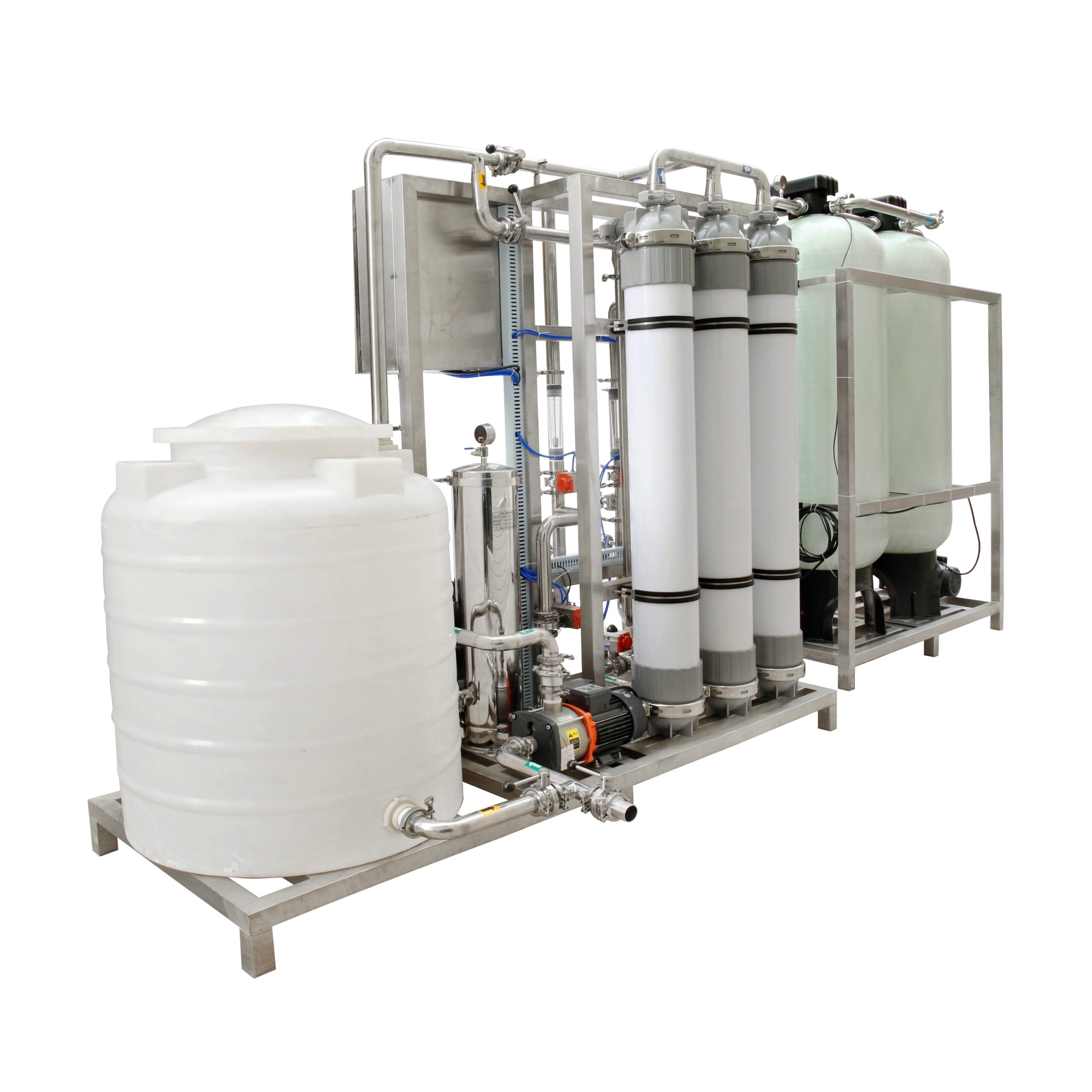Introduction
Ultrafiltration (UF) is a membrane separation technology used for the purification and separation of solutions. The ultrafiltration membrane system uses UF membrane fibers as the filtering medium, with the pressure difference across the membrane as the driving force. Ultrafiltration membranes allow solvents in the solution (such as water molecules), inorganic salts, and small organic molecules to pass through, while retaining larger molecules such as suspended solids, colloids, proteins, and microorganisms. This achieves the purpose of purification or separation.
YouTube video
- 500LPH UF Mineral Water Ultrafiltration System
- 2000LPH UF+1000LPH +500LPH RO系统
- 1000LPH UF water ultrafiltration system
Ultrafiltration product details
- 6TPH Ultrafiltration System
- 2000LPH RO System and 4000LPH UF System
- 1000LPH ultrafiltration water purification
- 6000LPH uf water filter system

Ultrafiltration Equipment Working Principle
Ultrafiltration is a membrane separation process that relies on sieving as the separation principle and pressure as the driving force. The filtration precision ranges from 0.005 to 0.01 μm, effectively removing particles, colloids, bacteria, pyrogens, and high molecular organic substances from water. It is widely used in separation, concentration, and purification of substances. The ultrafiltration process involves no phase transition and operates at room temperature, making it especially suitable for the separation of heat-sensitive substances. It also has excellent resistance to temperature, acid, alkali, and oxidation, allowing continuous operation below 60°C and with a pH range of 2-11.
Classification of Ultrafiltration Membranes
Ultrafiltration membranes are classified into various structural forms such as plate and frame (plate type), hollow fiber, nanomembrane surface ultrafiltration, tubular, and spiral wound membranes. Among them, hollow fiber ultrafiltration membranes are one of the most mature and advanced forms of ultrafiltration technology. The outer diameter of hollow fibers ranges from 0.4 to 2.0 mm, with an inner diameter of 0.3 to 1.4 mm. The walls of the hollow fibers are filled with micropores, with pore sizes expressed by the molecular weight of the substances they can retain, which can range from thousands to hundreds of thousands. Raw water is pressurized to flow either outside or inside the hollow fibers, forming either an outside-in or inside-out hollow fiber ultrafiltration membrane. Ultrafiltration is a dynamic filtration process where retained substances are removed with the concentrate, preventing clogging of the membrane surface and allowing for long-term continuous operation.
Applications of Ultrafiltration Technology
Early industrial applications of ultrafiltration were in wastewater and sewage treatment. Over the past thirty years, with the development of ultrafiltration technology, the application fields of ultrafiltration membrane technology have become extensive, including the food industry, beverage industry, dairy industry, bio-fermentation, biopharmaceuticals, pharmaceutical chemicals, biological preparations, traditional Chinese medicine preparations, clinical medicine, textile wastewater, food industry wastewater treatment, resource recovery, and environmental engineering.
Advantages of Ultrafiltration Equipment
- A. Ultrafiltration membrane elements use imported or domestic membranes, ensuring customers receive organic membrane elements that guarantee retention performance and membrane flux.
- B. The system has a high recovery rate, producing high-quality products and enabling the separation, purification, and high-level concentration of materials.
- C. The process involves no phase change, has no adverse effects on the composition of materials, and the separation, purification, and concentration processes occur at room temperature, making it particularly suitable for handling heat-sensitive substances. This avoids the disadvantages of high temperatures that can destroy bioactive substances, effectively preserving the bioactive substances and nutrients in the original material system.
- D. The system has low energy consumption, short production cycles, and lower operating costs compared to traditional process equipment, effectively reducing production costs and improving economic efficiency for enterprises.
- E. The system’s design is advanced, with a high degree of integration, compact structure, small footprint, easy operation, and maintenance, resulting in low labor intensity.
- F. The system uses sanitary-grade pipes and valves, ensuring cleanliness and hygiene on-site, meeting GMP or FDA production standards.
- G. The control system can be customized according to user requirements, combining advanced control software for on-site online centralized monitoring of important process parameters, preventing human error and ensuring long-term stable operation of the system.
Application Areas
- Mineral Water: Ultrafiltration technology is applied in mineral water production. In engineering design, the pore size and type of the membrane will be selected based on the source water quality analysis report.
- Food: Ultrafiltration technology is increasingly used in the production of dairy products, fruit juices, wines, and condiments. It offers advantages in economic efficiency, reliability, and quality assurance over traditional methods, such as separating proteins and low-molecular-weight lactose from milk or whey, clarifying and sterilizing fruit juices, removing colored proteins, polysaccharides, and other colloidal impurities from wine, and removing bacteria from soy sauce and vinegar.
- Pharmaceuticals: Ultrafiltration technology is well-suited for the separation and purification of heat-sensitive substances in pharmaceutical and biochemical production. Ultrafiltration is highly suitable for concentrating biological active substances (such as enzymes, viruses, nucleic acids, special proteins) and for the extraction of drugs (such as alkaloids, hormones) from plants or animals, often containing large molecules or solid substances that can be separated by ultrafiltration, thereby improving product quality.
- Pure Water, Ultrapure Water: Primary purification of industrial water, RO pre-treatment, and final treatment of pure water and ultrapure water.
- Environmental Protection: Deep treatment of industrial wastewater, urban water reuse systems, recovery of electrophoretic paint and oils.
- Fermentation: Separation and purification of biochemical fermentation liquids, concentration and purification of enzymes, and clarification filtration of sugars and xylitol.
